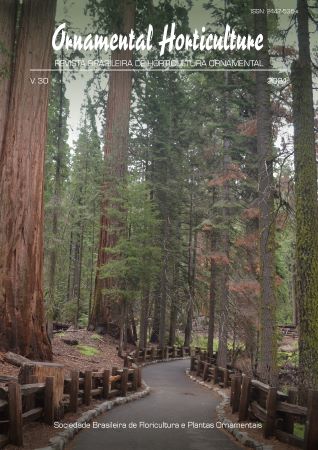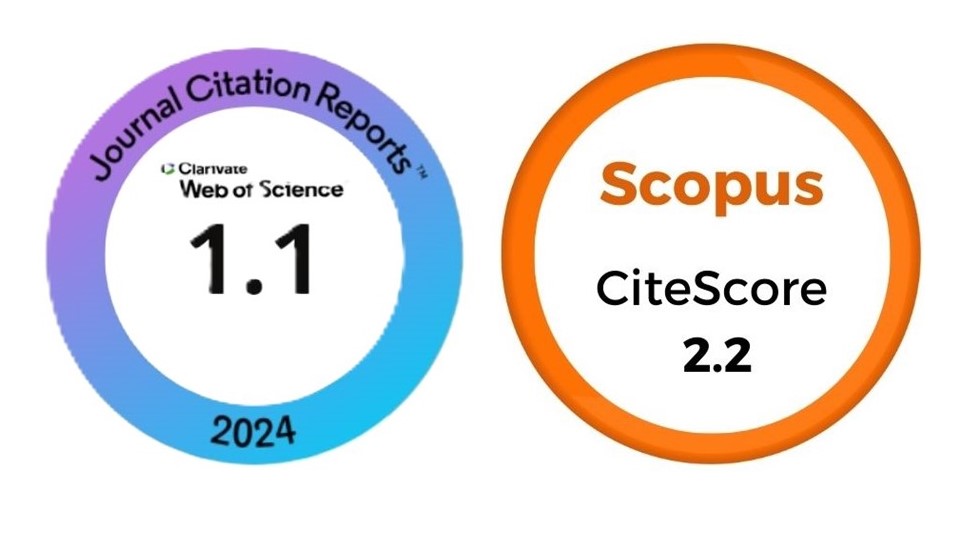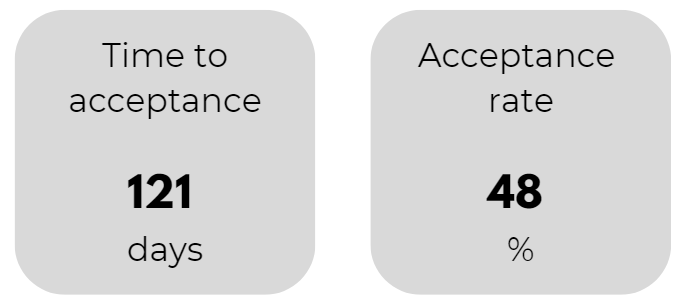Plantas ornamentais da família Rubiaceae: estado atual e avaliação da potência de sua fitocenose para jardinagem de quintais na Martinica
DOI:
https://doi.org/10.1590/2447-536X.v30.e242778Palavras-chave:
botânica, diversidade florística, ecologia, estéticaResumo
Rubiaceae é a quarta maior família de plantas com flores do mundo. É uma família cosmopolita, presente em todos os continentes, mas grande parte da sua diversidade está localizada em regiões tropicais e subtropicais. Algumas espécies da família são consideradas entre as mais belas e populares do mundo, mas há poucos dados sobre a importância e contribuição de exemplares ornamentais da famíliaRubiaceae para o próspero mercado global de plantas ornamentais. A ilha da Martinica localizada no arquipélago das Pequenas Antilhas, no Caribe, abriga parte desta diversidade da família Rubiaceae. Apesar das importações significativas de plantas ornamentais para as Índias Ocidentais Francesas, estas espécies são quase inexistentes nos jardins privados da Martinica, com exceção dos géneros Ixora, Mussaenda e Gardenia. Utilizando levantamentos etnobotânicos, demonstramos que a família Rubiaceae contribui apenas muito fracamente para a diversidade de plantas ornamentais em jardins privados no norte da ilha.
Downloads
Referências
BUSINESS RESEARCH INSIGHTS. 2024. Estimated global market for ornamental plants. Available at: <https://www.businessresearchinsights.com/fr/market-reports/flower-and-ornamental-plants-market-103548> Accessed on June 2024.
C3AF (Climate change and its consequences for the French West Indies). 2024. Climate database. Available at: <https://c3af.univ-montp3.fr/1-faq.html> Accessed on June 2024.
CHANIAD, P.; PHUWAJAROANPONG, A.; TECHARANG, T.; VIRIYAVEJAKUL, P.; CHUKAEW, A.; PUNSAWAD, C. Antiplasmodial activity and cytotoxicity of plant extracts from the Asteraceae and Rubiaceae families. Heliyon, v.8, n.1, 2022. https://doi.org/10.1016/j.heliyon.2022.e08848
CLAUDE, J.P.; JOSEPH, P.; ABATI, Y.; MAJOR, P.; YANIS, J.F.; SEVERINE, E.M.; SOPHIE, S. Considerations on the ecology of Rubiaceae in Martinique (Lesser Antilles). Ecology Environment and Conservation (EM International), v.29, n.3, p.1001-1023, 2023. http://doi.org/10.53550/EEC.2023.v29i03.001
DGCCRS (Directorate General for the Economy, Competition, Consumer Affairs and Services, France). 2024. Estimated imports of ornamental plants to the French West Indies. Available at: <https://www.douane.gouv.fr/fiche/consulter-les-statistiques-du-commerce-exterieur-de-la-france>. Accessed on June 2024.
DUBEY, K.; PRAKASH, S. Economic importance of Angiosperm. Economic Importance of Different Classes of Plants, 2021.
FOURNET, J. Flore illustrée des phanérogames de Guadeloupe et de Martinique. Montpellier. Gondwana: CIRAD-Editions, 2002.
GANASSALI, S. Enquêtes et analyse de données avec Sphinx: Livre+plateforme interactive eText-Licence 12 mois. France: Pearson Education France, 2014.
GONZÁLEZ-CASTELAZO, F.; SORIA-JASSO, L.E.; TORRE-VILLALVAZO, I.; CARIÑO-CORTES, R.; MUÑOZ-PEREZ, V.M.; ORTIZ, M.I.; FERNANDEZ-MARTINEZ, E. Plants of the Rubiaceae family with effect on metabolic syndrome: constituents, pharmacology, and molecular targets. Plants, v.12, n.20, p.3583, 2023. https://doi.org/10.3390/plants12203583
GROS-DESORMEAUX, J.R.; TUPIASSU, L.; MAUVOIS, G.; COISY, C. Les valeurs universelles exceptionnelles des aires forestières patrimoniales des petites antilles: les cas emblématiques des îles de la dominique et de la martinique. Novos Cadernos NAEA, v.22, n.1, p.9-31, 2019. http://dx.doi.org/10.5801/ncn.v22i1.6629
HOWARD, R.A. Flora of the Lesser Antilles: Dicotyledoneae, pt. 2. Harvard: Arnold Arboretum, Harvard University, 1989. https://doi.org/10.5962/t.187734
INSEE (National Institute of Statistics and Economic Studies in France). 2021. Statistical database on the demography and economy of Martinique. Available at: <https://www.insee.fr/fr/accueil>. Accessed on June 2024.
JAAFAR, A.; ZULKIPLI, M.A.; HATTA, F. H. M.; JAHIDIN, A.H.; NASIR, N.A.A.; HASAN, M.H. Therapeutic potentials of iridoids derived from Rubiaceae against in vitro and in vivo inflammation: A scoping review. Saudi Pharmaceutical Journal, p.101876, 2023. https://doi.org/10.1016/j.jsps.2023.101876
JOSEPH, P. Climax phase forest species of the lesser Antilles Forests. International Journal of Recent Research and Review, v.VIII, n.4, p.57-69, 2015.
JOSEPH, P.; CLAUDE, J.P.; ABATI, Y. «Some considerations on the medicinal botany of the lesser Antilles: The case of Martinique”. University of the French West Indies, UMR Espace Dev - Bioreca. Journal of Medicinal Plants Studies, v.12, n.4, part A, 2024. https://doi.org/10.22271/plants.2024.v12.i4a.1692
JOSEPH, P.; CLAUDE, J.P.; BAILLARD, K.; ABATI, Y.; JEAN-FRANCOIS, Y.; MAJOR, P.; SOPHIE, S.. Contribution to the knowledge of the phytocenotic diversity of the lesser Antilles revisiting some old and more recent floristic data. Open Access Library Journal, v.7, n.3, p.1-44, 2020. https://doi.org/10.4236/oalib.1106191
KAGISHA, V.; MARINI DJANG’EING’A, R.; MUGANGA, R.; BONNET, O.; TCHINDA, A.T.; JANSEN, O.; FREDERICH, M. Pentas longiflora Oliv. (Rubiaceae), a plant used in the treatment of Pityriasis Versicolor in Rwanda: Chemical composition and standardization of leaves and roots. Fitoterapia, v.153, p.104974, 2021. https://doi.org/10.1016/j.fitote.2021.104974
KAUSHIK, C.; SINGH, M.V. An updated phytopharmacological review on Hamelia patens Jacq. International Journal of Pharmacognosy, v.7, p.52-61, 2020. http://dx.doi.org/10.13040/IJPSR.0975-8232.IJP.7(3).52-61
LEMOIGNE, N. MAITI, D.; BHATTACHARJEE, B.; KUMAR SINGHA, A.; GHOSH, R.; DE, C. Antimicrobial, antioxidant and anti α-glucosidase activities of the leaf extract from Mussaenda Roxburghii Hook. F.(Rubiaceae). World Journal of Pharmacy and Pharmaceutical Sciences, v.2, p.3216-3228, 2015.
MARC, J.V. Le jardin créole à Fort-de-France: stratégie de résistance face à la pauvreté?. VertigO-la revue électronique en sciences de l’environnement, v.11, n.1, 2011. https://doi.org/10.4000/vertigo.10804
MARC, J.V.; MARTOUZET, D. Les jardins créoles et ornementaux comme indicateurs socio-spatiaux: analyse du cas de Fort-de-France. VertigO-la revue électronique en sciences de l’environnement, Hors-série 14. 2012. https://doi.org/10.4000/vertigo.12526
NOOR, G.; AHMAD, M.A.; AHSAN, F.; MAHMOOD, T.; ARIF, M.; KHUSHTAR, M. A phytochemical and ethnopharmacological recapitulation on Hamelia patens. Drug research, v.70, n.5, p.188-198, 2020. https://doi.org/10.1055/a-1131-7856
PUTRI, D.M.; JUNAEDI, D.I.; HENDRIAN, R. Ornamental plant’s potentials of Indonesian native Rubiaceae collected in Cibodas Botanical Garden. International Journal of Agriculture System, v.9, n.1, p.1-9, 2021. http://dx.doi.org/10.20956/ijas.v9i1.2718
RAZAFIMANDIMBISON, S.G.; RYDIN, C. Phylogeny and classification of the coffee family (Rubiaceae, Gentianales): Overview and outlook. Taxon, v.73, n.3, p.673-717, 2024. https://doi.org/10.1002/tax.13167
ROY, D.; BRAR, S.; BHATIA, R.; RANGRA, N.K. An insight into the ethnopharmacological importance of Indian subcontinent medicinal plant species of Rubiaceae family. ADV TRADIT MED (ADTM). 2023. https://doi.org/10.1007/s13596-023-00714-1
RUSHDAN, N.A.N.A.; AB GHANI, N.; RASOL, N.E. Review on anthraquinones isolated from Rubiaceae family. Journal of Science and Mathematics Letters, v.11, p.163-174, 2023. https://doi.org/10.37134/jsml.vol11.sp.18.2023
SOUBEYRAN, Y. Espèces exotiques envahissantes dans les collectivités françaises d’outre-mer: état des lieux et recommandations. Aurillac: Comité français de l’UICN, 2008.
WITTMANN, A.L.; FLORES-FERRER, A. Analyse économique des espèces exotiques envahissantes en France. Première enquête nationale (2009–2013). Commissariat Général au Développement Durable, Études & Documents, no 130. 2015.
Downloads
Publicado
Edição
Seção
Licença
Copyright (c) 2024 Ornamental Horticulture

Este trabalho está licenciado sob uma licença Creative Commons Attribution 4.0 International License.








